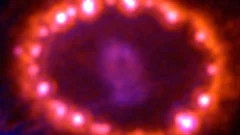Media Releases
Future Technologies
Space
Processes in stars recreated with isotopes from PSIIsotopes that otherwise only naturally exist in exploding stars à supernovae à are formed at the Paul Scherrer Institute’s research facilities. This enables processes that take place inside the stars to be recreated in the lab. For instance, an international team of researchers used the titanium isotope Ti-44 to study one such process at CERN in Geneva. In doing so, it became evident that it is less effective than was previously believed and the previous theoretical calculations of processes in stars need to be corrected.


